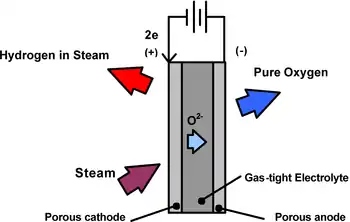High-temperature electrolysis
High-temperature electrolysis (also HTE or steam electrolysis or HTSE) is a technology for producing hydrogen from water at high temperatures.[1]

Efficiency

60% efficient at 1000°C
Steam reforming of hydrocarbons to hydrogen is 70-85% efficient[3]
High temperature electrolysis is more efficient economically than traditional room-temperature electrolysis because some of the energy is supplied as heat, which is cheaper than electricity, and also because the electrolysis reaction is more efficient at higher temperatures. In fact, at 2500 °C, electrical input is unnecessary because water breaks down to hydrogen and oxygen through thermolysis. Such temperatures are impractical; proposed HTE systems operate between 100 °C and 850 °C.[4][5][6]
If one assumes that the electricity used comes from a heat engine, it takes 141.86 megajoules (MJ) of heat energy to produce one kg of hydrogen, for the HTE process itself and for the electricity required. At 100 °C, 350 MJ of thermal energy are required (41% efficient). At 850 °C, 225 MJ are required (64% efficient). Above 850 °C, one begins to exceed the capacity of standard chromium steels to resist corrosion,[7] and it's already no easy matter to design and implement an industrial scale chemical process to operate at such a high temperature point.
Materials
The selection of the materials for the electrodes and electrolyte in a solid oxide electrolyser cell is essential. One option being investigated for the process[8] used yttria-stabilized zirconia (YSZ) electrolytes, Nickel (Ni)-cermet steam/Hydrogen electrodes, and mixed Oxide of Lanthanum oxide (La2O3), Strontium and Cobalt oxygen electrodes.
Economic potential
Even with HTE, electrolysis is a fairly inefficient way to store energy. Significant conversion losses of energy occur both in the electrolysis process, and in the conversion of the resulting hydrogen back into power.
At current hydrocarbon prices, HTE can not compete with pyrolysis of hydrocarbons as an economical source of hydrogen, which produces carbon dioxide as a by-product.
HTE is of interest as a more efficient route to the production "green" hydrogen, to be used as a carbon neutral fuel and general energy storage. It may become economical if cheap non-fossil fuel sources of heat (concentrating solar, nuclear, geothermal, waste heat) can be used in conjunction with non-fossil fuel sources of electricity (such as solar, wind, ocean, nuclear).
Possible supplies of cheap high-temperature heat for HTE are all nonchemical, including nuclear reactors, concentrating solar thermal collectors, and geothermal sources. HTE has been demonstrated in a laboratory at 108 kilojoules (electric) per gram of hydrogen produced,[9] but not at a commercial scale.[10]
Alternatives
There are hundreds of thermochemical cycles known to use heat to extract hydrogen from water. For instance, the thermochemical sulfur-iodine cycle. Since the electricity generation step has a fairly low efficiency and is eliminated, thermochemical production might reach higher efficiencies than HTE. However, large-scale thermochemical production will require significant advances in materials that can withstand high-temperature, high-pressure, highly corrosive environments.
United States Department of Energy
The DOE Office of Nuclear Energy has demonstration projects to test 3 nuclear facilities with high-temperature electrolysis in the United States at:[11]
Mars ISRU
High temperature electrolysis with solid oxide electrolyser cells was used to produce 5.37 grams of oxygen per hour on Mars from atmospheric carbon dioxide for the Mars Oxygen ISRU Experiment in the NASA Mars 2020 Perseverance rover, using zirconia electrolysis devices.[12][13][14]
See also
References
Footnotes
- Hauch, A.; Ebbesen, S. D.; Jensen, S. H.; Mogensen, M. (2008). "Highly Efficient high temperature electrolysis". J. Mater. Chem. 18 (20): 2331–2340. doi:10.1039/b718822f.
- https://inldigitallibrary.inl.gov/sites/sti/sti/4480292.pdf
- https://www.hindawi.com/journals/cpis/2013/690627/
- Badwal, SPS; Giddey S; Munnings C (2012). "Hydrogen production via solid electrolytic routes". WIREs Energy and Environment. 2 (5): 473–487. doi:10.1002/wene.50. S2CID 135539661.
- Hi2h2 - High temperature electrolysis using SOEC
- Final Report Summary – WELTEMP (Water Electrolysis at Elevated Temperatures)
- "Stainless Steel - High Temperature Resistance". azom.com. AZO Materials. 8 January 2002. Retrieved 6 August 2021.
Most austenitic steels, with chromium contents of at least 18%, can be used at temperatures up to 870°C and [specialized grades] even higher.
- Kazuya Yamada, Shinichi Makino, Kiyoshi Ono, Kentaro Matsunaga, Masato Yoshino, Takashi Ogawa, Shigeo Kasai, Seiji Fujiwara, and Hiroyuki Yamauchi "High Temperature Electrolysis for Hydrogen Production Using Solid Oxide Electrolyte Tubular Cells Assembly Unit", presented at AICHE Annual Meeting, San Francisco, California, November 2006. abstract
- "Steam heat: researchers gear up for full-scale hydrogen plant" (Press release). Science Daily. 2008-09-19.
- "Nuclear hydrogen R&D plan" (PDF). U.S. Dept. of Energy. March 2004. Archived from the original (PDF) on 2013-09-24. Retrieved 2008-05-09.
- https://www.energy.gov/ne/articles/3-nuclear-power-plants-gearing-clean-hydrogen-production
- Wall, Mike (August 1, 2014). "Oxygen-Generating Mars Rover to Bring Colonization Closer". Space.com. Retrieved 2014-11-05.
- The Mars Oxygen ISRU Experiment (MOXIE) PDF. Presentation: MARS 2020 Mission and Instruments". November 6, 2014.
- Potter, Sean (2021-04-21). "NASA's Perseverance Mars Rover Extracts First Oxygen from Red Planet". NASA. Retrieved 2021-04-22.